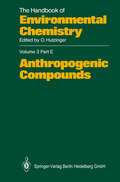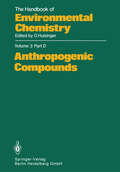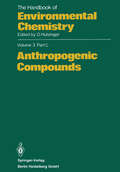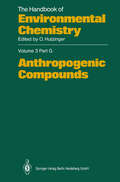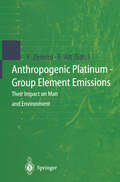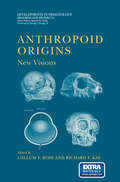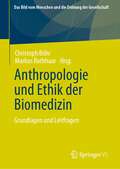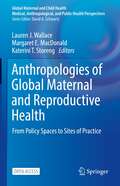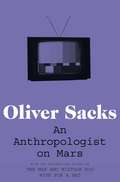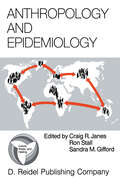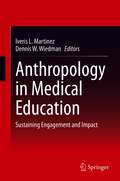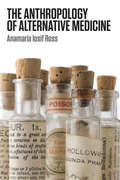- Table View
- List View
Anthropogenic Compounds (The Handbook of Environmental Chemistry #3 / 3E)
by Freddy Adams Stephen J. Blunden Rudy Van Cleuvenbergen C. J. Evans Lawrence Fishbein Urs-Josef Rickenbacher Christian Schlatter Alfred SteineggerAn important purpose of The Handbook of Environmental Chemistry is to aid the understanding of distribution and chemical reaction processes which occur in the environment. It is designed to serve as an important source for environmental scientists and decision-makers in industry, governmental and regulatory bodies. Volume 3, Part E of this series is dedicated to organometallic compounds, aluminium and to chemicals used in the rubber industry.
Anthropogenic Compounds (The Handbook of Environmental Chemistry #3 / 3D)
by R. F. Addison A. B. McKague A. Larsson D. J. McLeay P. E. Ney G. A. Parker D. Rivin G. Sundström M. Tarkpea C. C. WaldenAnthropogenic Compounds (The Handbook of Environmental Chemistry #3 / 3C)
by E. Atlas L. Fishbein C. S. Giam J. E. Leonard D.C.G. Muir M.A. Jr. Powers J. SchoerEnvironmental Chemistry is a relatively young science. Interest in this subject, however, is growing very rapidly and, although no agreement has been reached as yet about the exact content and limits of this interdisciplinary discipline, there appears to be increasing interest in seeing environmental topics which are based on chemistry embodied in this subject. One of the first objectives of Environmental Chemistry must be the study of the environment and of natural chemical processes which occur in the environment. A major purpose of this series on Environmental Chemistry, therefore, is to present a reasonably uniform view of various aspects of the chemistry of the environment and chemical reactions occurring in the environment. The industrial activities of man have given a new dimension to Environmental Chemistry. We have now synthesized and described over five million chemical compounds and chemical industry produces about hundred and fifty million tons of synthetic chemicals annually. We ship billions of tons of oil per year and through mining operations and other geophysical modifications, large quantities of inorganic and organic materials are released from their natural deposits. Cities and metropolitan areas of up to 15 million inhabitants produce large quantities of waste in relatively small and confined areas. Much of the chemical products and waste products of modern society are released into the environment either during production, storage, transport, use or ultimate disposal. These released materials participate in natural cycles and reactions and frequently lead to interference and disturbance of natural systems.
Anthropogenic Compounds (The Handbook of Environmental Chemistry #3 / 3G)
by Franzkarl Brochhagen Elizabeth P. Burrows Heidelore Fiedler J. Konietzko Wayne R. Mitchell Klaus Mross W. Mücke David L. Parmer David H. RosenblattEnvironmental Chemistry is a relatively young science. Interest in this subject, however, is growing very rapidly and, although no agreement has been reached as yet about the exact content and limits of this interdisciplinary subject, there appears to be increasing interest in seeing environmental topics which are based on chemistry embodied in this subject. One of the first objectives of Environ mental Chemistry must be the study of the environment and of natural chemical processes which occur in the environment. A major purpose of this series on Environmental Chemistry, therefore, is to present a reasonably uniform view of various aspects of the chemistry of the environment and chemical reactions occurring in the environment. The industrial activities of man have given a new dimension to Environ mental Chemistry. We have now synthesized and described over five million chemical compounds and chemical industry produces about one hundred and fifty million tons of synthetic chemicals annually. We ship billions of tons of oil per year and through mining operations and other geophysical modifications, large quantities of inorganic and organic materials are released from their natural deposits. Cities and metropolitan areas of up to 15 million inhabitants produce large quantities of waste in relatively small and confined areas. Much of the chemical products and waste products of modern society are released into the environment either during production, storage, transport, use or ultimate disposal. These released materials participate in natural cycles and reactions and frequently lead to interference and disturbance of natural systems.
Anthropogenic Platinum-Group Element Emissions: Their Impact on Man and Environment
by FriedrichAlt FathiZereiniSince the implementation of catalysts containing platinum-group-elements (PGE) for the control of vehicle emissions in 1975, a controversial discussion has begun on PGE emissions and eventual consequences for the environment. However, a comprehensive overview of the various works and results in different scientific areas is still lacking. This book covers all aspects of anthropogenic PGE emissions and their consequences for man and environment. The interdisciplinary approach is substantiated by contributions from the fields of environmental geosciences, analytical chemistry, biology and occupational medicine. The articles mirror the actual status of scientific work and discuss environmentally related topics. Modern analytical methods for various environmental matrices as well as models of the current and future geochemical behaviour of PGE in the environment are presented. Bioavailability and toxicological and allergic potentials are discussed.
Anthropoid Origins: New Visions (Developments in Primatology: Progress and Prospects)
by Callum F. Ross Richard F. KayAnthropological Perspectives on Care: Work, Kinship, and the Life-Course
by Erdmute AlberIn the course of last two decades, the notion of care has become prominent in the social and cultural sciences. As a result of this proliferation of care in several disciplinary fields, we are observing not only the expansion of its conceptual meaning, but also an increasing imprecision in its usage. A growing amount of literature focuses on the intersection between work, gender, ethnicity, affect, and mobility regimes. In view of this growing field of literature, Anthropological Perspectives on Care looks at the notion of care from an anthropological perspective. Complementing earlier approaches, Alber and Drotbohm argue that an interpretation of care in relation to three different concepts, namely work, kinship and the life-course, will facilitate empirical and conceptual distinctions between the different activities that are labeled as care.
Anthropologie und Ethik der Biomedizin: Grundlagen und Leitfragen (Das Bild vom Menschen und die Ordnung der Gesellschaft)
by Christoph Böhr Markus RothhaarIn bioethische Kontroversen geht es zumeist um den Umgang des Menschen mit sich selbst, genauer: den Umgang mit den biologischen Grundlagen seiner – der menschlichen – Existenz. Bioethik verweist darum immer auch auf den Begriff des Menschen und damit auf die philosophische Anthropologie. Diese anthropologische Dimension der Bioethik bleibt allerdings oft unausgesprochen und unreflektiert. Der vorliegende Band versucht diese Lücke zu schließen, indem er die Bioethik, sowohl in den Grundlagen, als auch in der Behandlung konkreter Fragestellungen, von der Embryonenforschung und der Reproduktionsmedizin über die Gentechnologie und den sogenannten Transhumanismus bis hin zur Sterbebegleitung, konsequent vom Begriff des Menschen her zu denken versucht.
Anthropologies of Cancer in Transnational Worlds (Routledge Studies in Anthropology)
by Holly F. Mathews Nancy J. Burke Eirini KamprianiCancer is a transnational condition involving the unprecedented flow of health information, technologies, and people across national borders. Such movement raises questions about the nature of therapeutic citizenship, how and where structurally vulnerable populations obtain care, and the political geography of blame associated with this disease. This volume brings together cutting-edge anthropological research carried out across North and South America, Europe, Africa and Asia, representing low-, middle- and high-resource countries with a diversity of national health care systems. Contributors ethnographically map the varied nature of cancer experiences and articulate the multiplicity of meanings that survivorship, risk, charity and care entail. They explore institutional frameworks shaping local responses to cancer and underlying political forces and structural variables. Chapter 3 of this book is freely available as a downloadable Open Access PDF under a Creative Commons Attribution-Non Commercial-No Derivatives 3.0 license. https://s3-us-west-2.amazonaws.com/tandfbis/rt-files/docs/Open+Access+Chapters/9781138776937_oachapter3.pdf
Anthropologies of Cancer in Transnational Worlds (Routledge Studies in Anthropology)
by Holly F. Mathews Nancy J. Burke Eirini KamprianiCancer is a transnational condition involving the unprecedented flow of health information, technologies, and people across national borders. Such movement raises questions about the nature of therapeutic citizenship, how and where structurally vulnerable populations obtain care, and the political geography of blame associated with this disease. This volume brings together cutting-edge anthropological research carried out across North and South America, Europe, Africa and Asia, representing low-, middle- and high-resource countries with a diversity of national health care systems. Contributors ethnographically map the varied nature of cancer experiences and articulate the multiplicity of meanings that survivorship, risk, charity and care entail. They explore institutional frameworks shaping local responses to cancer and underlying political forces and structural variables. Chapter 3 of this book is freely available as a downloadable Open Access PDF under a Creative Commons Attribution-Non Commercial-No Derivatives 3.0 license. https://s3-us-west-2.amazonaws.com/tandfbis/rt-files/docs/Open+Access+Chapters/9781138776937_oachapter3.pdf
Anthropologies of Global Maternal and Reproductive Health: From Policy Spaces to Sites of Practice (Global Maternal and Child Health)
by Lauren J. Wallace Margaret E. MacDonald Katerini T. StorengThis open access edited book brings together new research on the mechanisms by which maternal and reproductive health policies are formed and implemented in diverse locales around the world, from global policy spaces to sites of practice. The authors – both internationally respected anthropologists and new voices – demonstrate the value of ethnography and the utility of reproduction as a lens through which to generate rich insights into professionals’ and lay people’s intimate encounters with policy. Authors look closely at core policy debates in the history of global maternal health across six different continents, including: Women’s use of misoprostol for abortion in Burkina FasoThe place of traditional birth attendants in global maternal healthDonor-driven maternal health programs in TanzaniaEfforts to integrate qualitative evidence in WHO maternal and child health policy-making Anthropologies of Global Maternal and Reproductive Health will engage readers interested in critical conversations about global health policy today. The broad range of foci makes it a valuable resource for teaching in medical anthropology, anthropology of reproduction, and interdisciplinary global health programs. The book will also find readership amongst critical public health scholars, health policy and systems researchers, and global public health practitioners.
Anthropologies of Medicine: A Colloquium on West European and North American Perspectives
by Beatrix Pfleiderer, Gilles BibeauAn Anthropologist on Mars: Seven Paradoxical Tales
by Oliver Sacks'An inexhaustible tourist at the farther reaches of the mind, Sacks presents, in sparse, unsentimental prose, the stories of seven of his patients. The result is as rich, vivid and compelling as any collection of short fictional stories' Independent on Sunday As with his previous bestseller, The Man Who Mistook His Wife for a Hat, in An Anthropologist on Mars Oliver Sacks uses case studies to illustrate the myriad ways in which neurological conditions can affect our sense of self, our experience of the world, and how we relate to those around us. Writing with his trademark blend of scientific rigour and human compassion, he describes patients such as the colour-blind painter or the surgeon with compulsive tics that disappear in the operating theatre; patients for whom disorientation and alienation - but also adaptation - are inescapable facts of life.
Anthropology and Epidemiology: Interdisciplinary Approaches to the Study of Health and Disease (Culture, Illness and Healing #9)
by Sandra M. Gifford Ron Stall Craig R. JanesOver the past two decades increasing interest has emerged in the contribu tions that the social sciences might make to the epidemiological study of patterns of health and disease. Several reasons can be cited for this increasing interest. Primary among these has been the rise of the chronic, non-infectious diseases as important causes of morbidity and mortality within Western populations during the 20th century. Generally speaking, the chronic, non infectious diseases are strongly influenced by lifestyle variables, which are themselves strongly influenced by social and cultural forces. The under standing of the effects of the behavioral factors in, say, hypertension, thus requires an understanding of the social and cultural factors which encourage obesity, a sedentary lifestyle, non-compliance with anti-hypertensive medica tions (or other prescribed regimens), and stress. Equally, there is a growing awareness that considerations of human behavior and its social and cultural determinants are important for understanding the distribution and control of infectious diseases. Related to this expansion of epidemiologic interest into the behavioral realm 'has been the development of etiological models which focus on the psychological, biological and socio-cultural characteristics of hosts, rather than exclusive concern with exposure to a particular agent or even behavioral risk. Also during this period advances in statistical and computing techniques have made accessible the ready testing of multivariate causal models, and so have encouraged the measurement of the effects of social and cultural factors on disease occurrence.
Anthropology and International Health: South Asian Case Studies (Culture, Illness and Healing #15)
by M. NichterIn this book I present a series of eleven essays written between 1978 and 1987 on subjects relevant to the anthropology of health and international health. The issues addressed in these essays were investigated during 38 months of fieldwork in rural southwest peninsular India (197 4-86) and 15 months of fieldwork in southwest Sri Lanka (1983-84 ). ;During various periods of this time I conducted ethnographic fieldwork, explored the feasibility of participatory community research, facilitated the development of a postgraduate health education training program, and served as a consultant to various international health organizations. The essays document my ongoing attempts to integrate academic interests in the anthropology of health with applications of anthropology for international health and development. The volume is divided into four sections structured around the themes of: ethnophysiology, illness ethnography, pharmaceutical related behavior, and health communication. Included are studies of fertility and pregnancy (Chapters 1 and 2), states of malnutrition and approaches to nutrition education (Chapters 5 and 11 ), diarrheal disease and water boiling behavior (Chapters 6 and 1 0), and lay perceptions of fertility control methods and medicines (Chapters 3 and 7). Emerging from these studies is a recognition that perceptions of ethnophysiology and contingent health concerns signifi cantly influence health behavior and the use as well as demand for traditional and modern health resources.
Anthropology and Psychoanalysis: An Encounter Through Culture
by Ariane Deluz Suzette HealdIn Anthropology and Psychoanalysis the contributors, both practising anthropologists and psychoanalysts, explore in detail the interface between the two disciplines and locate this within the history of both anthropology and psychoanalysis. In particular, they deal with the distinctive reactions of British, French and American anthropology to psychoanalysis and the way in which the present fracturing of each of these national traditions and their post-modern turn has led to a new willingness to investigate the relationships between the disciplines and the role of the unconscious in cultural life. They also address important issues of methodology, and present a critical discussion of the concept of culture and the academic specialisation of knowledge. Anthropology and Psychoanalysis will be invaluable reading to all anthropologists and psychoanalysts.
Anthropology and Psychoanalysis: An Encounter Through Culture
by Suzette Heald Ariane DeluzIn Anthropology and Psychoanalysis the contributors, both practising anthropologists and psychoanalysts, explore in detail the interface between the two disciplines and locate this within the history of both anthropology and psychoanalysis. In particular, they deal with the distinctive reactions of British, French and American anthropology to psychoanalysis and the way in which the present fracturing of each of these national traditions and their post-modern turn has led to a new willingness to investigate the relationships between the disciplines and the role of the unconscious in cultural life. They also address important issues of methodology, and present a critical discussion of the concept of culture and the academic specialisation of knowledge. Anthropology and Psychoanalysis will be invaluable reading to all anthropologists and psychoanalysts.
Anthropology in Medical Education: Sustaining Engagement and Impact
by Iveris L. Martinez Dennis W. WiedmanThis volume reflects on how anthropologists have engaged in medical education and aims to positively influence the future careers of anthropologists who are currently engaged or are considering a career in medical education. The volume is essential for medical educators, administrators, researchers, and practitioners, those interested in the history of medicine, global health, sociology of health and illness, medical and applied anthropology. For over a century, anthropologists have served in many roles in medical education: teaching, curriculum development, administration, research, and planning. Recent changes in medical education focusing on diversity, social determinants of health, and more humanistic patient-centered care have opened the door for more anthropologists in medical schools. The chapter authors describe various ways in which anthropologists have engaged and are currently involved in training physicians, in various countries, as well as potential new directions in this field. They address critical topics such as: the history of anthropology in medical education; humanism, ethics, and the culture of medicine; interprofessional and collaborative clinical care; incorporating patient perspectives in practice; addressing social determinants of health, health disparities, and cultural competence; anthropological roles in planning and implementation of medical education programs; effective strategies for teaching medical students; comparative analysis of systems of care in Japan, Uganda, France, United Kingdom, Mexico, Canada and throughout the United States; and potential new directions for anthropological engagement with medicine. The volume overall emphasizes the important role of anthropology in educating physicians throughout the world to improve patient care and population health.
The Anthropology of Alternative Medicine
by Anamaria Iosif RossAlternative medicine is not a fashionable new trend but an established cultural strategy, as well as a dynamic feature of mainstream contemporary medicine, in which elements of folk traditions are often blended with western scientific approaches.The Anthropology of Alternative Medicine is a concise yet wide-ranging exploration of non-biomedical healing. The book addresses a broad range of practices including: substance, energy and information flows (e.g. helminthic therapy); spirit, consciousness and trance (e.g. shamanism); body, movement and the senses (e.g. reiki and aromatherapy); as well as classical medical traditions as complements or alternatives to Western biomedicine (e.g. Ayurveda). Exploring the cultural underpinnings of contemporary healing methods, while assessing current ideas, topics and resources for further study, this book will be invaluable to undergraduate and graduate students in anthropology, sociology, psychology, and health related professions such as nursing, physical and occupational therapy, and biomedicine.
The Anthropology of Alternative Medicine
by Anamaria Iosif RossAlternative medicine is not a fashionable new trend but an established cultural strategy, as well as a dynamic feature of mainstream contemporary medicine, in which elements of folk traditions are often blended with western scientific approaches.The Anthropology of Alternative Medicine is a concise yet wide-ranging exploration of non-biomedical healing. The book addresses a broad range of practices including: substance, energy and information flows (e.g. helminthic therapy); spirit, consciousness and trance (e.g. shamanism); body, movement and the senses (e.g. reiki and aromatherapy); as well as classical medical traditions as complements or alternatives to Western biomedicine (e.g. Ayurveda). Exploring the cultural underpinnings of contemporary healing methods, while assessing current ideas, topics and resources for further study, this book will be invaluable to undergraduate and graduate students in anthropology, sociology, psychology, and health related professions such as nursing, physical and occupational therapy, and biomedicine.
The Anthropology of Child and Youth Care Work
by Jerome BekerThe Anthropology of Child and Youth Care Work presents and illustrates an anthropological model of child and youth care work and explores the associated benefits of such an approach. Author Rivka A. Eisikovits’model enhances workers’on-the-job effectiveness with clients and co-workers and improves intra- and inter-organizational communication with other human service providers. This book prepares child and youth care providers, educators, researchers, administrators, consultants, supervisors, and organizers to become change-sensitive, process-oriented observers, analysts, and co-designers of the systems within which they function and those with which they interact, such as families, communities, and referral agencies. The model presented in The Anthropology of Child and Youth Care Work offers readers an organic continuum between everyday work experience and conceptual practice, organizing such haphazard events into a systemized body of knowledge. Although providing specific skills, it is more than a technology--it is a humanistic worldview from which a humanistic practice philosophy can be derived. Specific points of this philosophy that child and youth care professionals learn about include: the cultural learning theory ethnographic inquiry and description staff-client relations the sick-role trap microcultural events in residential settings the relationship between treatment and education subsystems a heuristic approach to service delivery family cultural ethnography for cultural sensitizationEisikovits’anthropologic perspective broadens the horizons of child and youth care work and equips practitioners to transcend narrowly drawn organizational boundaries. By presenting caregivers as cultural translators between their clients and various decision-making forums, The Anthropology of Child and Youth Care Work prepares them to face the challenges of a dynamic emergent profession and helps them perform successfully in a rapidly changing social context that requires constant assessment of needs and evaluation of performance.
The Anthropology of Child and Youth Care Work
by Jerome BekerThe Anthropology of Child and Youth Care Work presents and illustrates an anthropological model of child and youth care work and explores the associated benefits of such an approach. Author Rivka A. Eisikovits’model enhances workers’on-the-job effectiveness with clients and co-workers and improves intra- and inter-organizational communication with other human service providers. This book prepares child and youth care providers, educators, researchers, administrators, consultants, supervisors, and organizers to become change-sensitive, process-oriented observers, analysts, and co-designers of the systems within which they function and those with which they interact, such as families, communities, and referral agencies. The model presented in The Anthropology of Child and Youth Care Work offers readers an organic continuum between everyday work experience and conceptual practice, organizing such haphazard events into a systemized body of knowledge. Although providing specific skills, it is more than a technology--it is a humanistic worldview from which a humanistic practice philosophy can be derived. Specific points of this philosophy that child and youth care professionals learn about include: the cultural learning theory ethnographic inquiry and description staff-client relations the sick-role trap microcultural events in residential settings the relationship between treatment and education subsystems a heuristic approach to service delivery family cultural ethnography for cultural sensitizationEisikovits’anthropologic perspective broadens the horizons of child and youth care work and equips practitioners to transcend narrowly drawn organizational boundaries. By presenting caregivers as cultural translators between their clients and various decision-making forums, The Anthropology of Child and Youth Care Work prepares them to face the challenges of a dynamic emergent profession and helps them perform successfully in a rapidly changing social context that requires constant assessment of needs and evaluation of performance.
Anthropology of Dying: A Participant Observation with Dying Persons in Germany
by Mira MenzfeldMira Menzfeld explores dying persons’ experiences of their own dying processes. She reveals cultural specificities of pre-exital dying in contemporary Germany, paying special attention to how concepts of dying ‘(un)well’ are perceived and realized by dying persons. Her methodological focus centers on classical ethnographic approaches: Close participant observation as well as informal and semi-structured conversations. For a better understanding of the specificities of dying in contemporary Germany, the author provides a refined definition catalogue of adequate terms to describe dying from an anthropological perspective.
An Anthropology of Lying: Information in the Doctor-Patient Relationship
by Sylvie FainzangIn the era of health democracy, where a patient’s right to be informed is not only widely advocated but also guaranteed by law, what is the real situation regarding patient information? Do patients receive the information that they request with regard to their diagnosis, prognosis or treatments? And what information do patients themselves give to their doctors? Drawing on observational research in hospitals and covering the exchanges between doctors and patients on the subject of cancer treatment and that of other pathologies, this book reveals that the practice of telling lies is widespread amongst parties on both sides of the medical relationship. With attention to the manner in which information of various types is withheld and the truth concealed on either side of the doctor-patient relationship, the author explores the boundaries between what is said and what is left unsaid, and between those who are given information and those who are lied to. Considering the misunderstandings that occur in the course of medical exchanges and the differences between the lies told by doctors and patients, An Anthropology of Lying: Information in the Doctor-Patient Relationship analyses the role of mendacity in the exercise of, and resistance to power. A fascinating study of the mechanisms at work and social conditions surrounding the accomplishment of lying in medical settings, this book casts fresh light on a subject that has so far been overlooked. As such, it will appeal not only to sociologists and anthropologists of health and medicine, but also to medical professionals.
An Anthropology of Lying: Information in the Doctor-Patient Relationship
by Sylvie FainzangIn the era of health democracy, where a patient’s right to be informed is not only widely advocated but also guaranteed by law, what is the real situation regarding patient information? Do patients receive the information that they request with regard to their diagnosis, prognosis or treatments? And what information do patients themselves give to their doctors? Drawing on observational research in hospitals and covering the exchanges between doctors and patients on the subject of cancer treatment and that of other pathologies, this book reveals that the practice of telling lies is widespread amongst parties on both sides of the medical relationship. With attention to the manner in which information of various types is withheld and the truth concealed on either side of the doctor-patient relationship, the author explores the boundaries between what is said and what is left unsaid, and between those who are given information and those who are lied to. Considering the misunderstandings that occur in the course of medical exchanges and the differences between the lies told by doctors and patients, An Anthropology of Lying: Information in the Doctor-Patient Relationship analyses the role of mendacity in the exercise of, and resistance to power. A fascinating study of the mechanisms at work and social conditions surrounding the accomplishment of lying in medical settings, this book casts fresh light on a subject that has so far been overlooked. As such, it will appeal not only to sociologists and anthropologists of health and medicine, but also to medical professionals.
